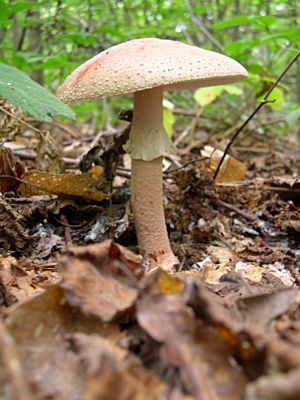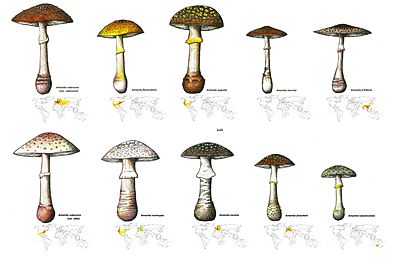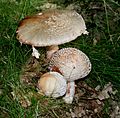Blusher facts for kids
Quick facts for kids Blusher |
|
|---|---|
 |
|
| Scientific classification |
| Amanita rubescens | |
|---|---|
| Mycological characteristics | |
| gills on hymenium | |
| cap is flat | |
| hymenium is free | |
| stipe has a ring | |
| spore print is white | |
| ecology is mycorrhizal | |
| edibility: edible but not recommended | |
The blusher is a common name for several types of mushrooms in the Amanita family. The most well-known are Amanita rubescens, found in Europe and eastern North America, and Amanita novinupta, which grows in western North America.
These mushrooms get their name, "blusher," because their flesh turns a pinkish color when you bruise or cut them. This is a special way to tell them apart from other mushrooms. Many people in Europe enjoy eating the blusher mushroom once it's cooked. However, new mushroom hunters need to be careful. Some very poisonous mushrooms look similar to the blusher, so it's important to know the differences.
Contents
What Does the Blusher Mushroom Look Like?
The European blusher mushroom has a cap that is reddish-brown and shaped like a dome. It can be from 5 to 15 centimeters wide. The cap is often covered with small white or mahogany-colored bumps. Sometimes, it might have a yellowish tint that can wash away in the rain.
The inside of the mushroom, called the flesh, is white. But here's the cool part: when you bruise it or expose it to air, it turns pink! This color change is super important. It helps you tell the blusher apart from a dangerous mushroom called the "panther cap" (Amanita pantherina). The panther cap's flesh does not turn pink.
The stem of the blusher mushroom is white. It often has hints of the same color as the cap. The stem can grow to be 5 to 15 centimeters tall. The gills, which are under the cap, are white and don't touch the stem. If you damage the gills, they will show red spots.
Around the stem, there's a ring that has ridges on its top side. This ridged ring is another clue to help you tell it apart from the panther cap. The mushroom's spores, which are like tiny seeds, are white and oval-shaped. They are about 8 by 5 micrometers in size.
When the blusher mushroom is raw, its taste is mild. However, it can leave a slightly sharp aftertaste. The mushroom doesn't have a strong smell. Sometimes, you might find that insects have been nibbling on these mushrooms.
Where Do Blusher Mushrooms Grow?
Blusher mushrooms are very common in much of Europe and eastern North America. In North America, there are actually at least three different types that are called Amanita amerirubescens. These mushrooms like to grow in poor soils. You can find them in forests with deciduous trees (trees that lose their leaves) and coniferous trees (like pine trees). In the UK, they usually appear from June to November.
Blusher mushrooms have also been found in South Africa. Scientists think they might have arrived there by accident, perhaps with trees brought over from Europe. They have also been seen in parts of Asia.
In eastern North America, a fungus called Hypomyces hyalinus sometimes grows on Amanita rubescens. When this happens, the mushroom can look very different. It can be hard to recognize unless you see healthy blusher mushrooms nearby. However, some still show the "blushing" color change.
Meet the Western Blusher: Amanita novinupta
There's a special type of blusher mushroom found in the western United States. It's called Amanita novinupta. For a long time, people often thought it was the same as A. rubescens. But recently, scientists officially described it as its own species.
Are There Other Blusher Types?
Yes, there are other types of mushrooms that are closely related to the blusher. These include Amanita brunneolocularis, A. orsonii, A. rubescens var. alba, and A. rubescens var. congolensis. They all share some features with the blusher.
Can You Eat Blusher Mushrooms?
You can eat Amanita rubescens, but it's very important to cook it first! When it's raw, the European A. rubescens contains a protein that can be harmful. Cooking the mushroom destroys this protein, making it safe to eat. Scientists are still learning if the North American A. rubescens and A. novinupta are also harmful when eaten raw. So, always cook blusher mushrooms before you try them!
Blusher Mushroom Pictures
See also
 In Spanish: Amanita rojiza para niños
In Spanish: Amanita rojiza para niños
- List of Amanita species









